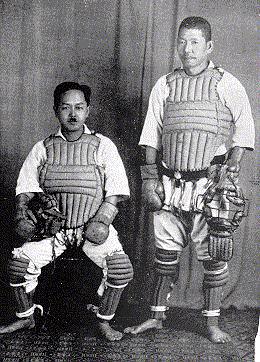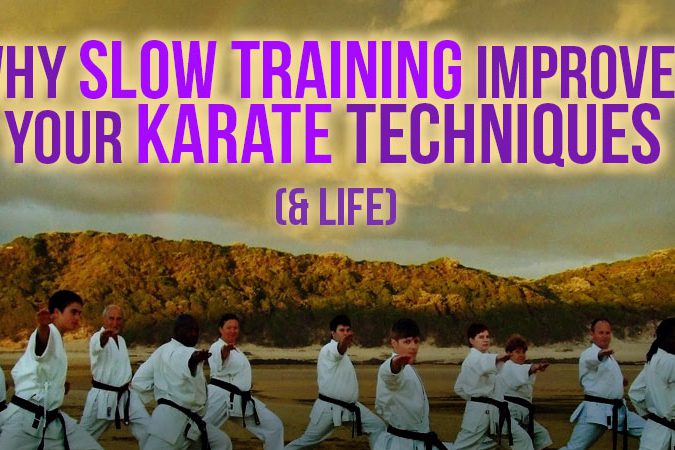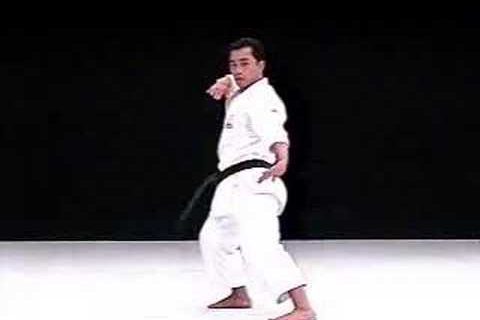Thirteen.
That’s how many letters Iain Abernethy’s name contains.
Thirteen is also the number of letters in the phrase “awesome bunkai”.
Coincidence?
I think not.

You see, when it comes to applying the techniques of Karate’s kata (bunkai), few people have the same passion, grit and experience as Iain Abernethy – UK’s leading proponent of practical Karate.
Having hustled on the bunkai corner for years, steadily converting regular Karate people into serial bunkai addicts through his numerous videos, articles and seminars, sensei Iain truly embodies the ideal Karate Nerd™.
If you ever meet him, I’m sure you’ll agree.
So…
Since the response to my last article (The Bunkai Blueprint: A Simple Framework for Applying the Kata of Karate in Practical Self-Defense) was so great, I figured – why not keep rolling on this whole “bunkai bandwagon”?
I mean, people are obviously thirsty for unlocking the secrets of kata!
Therefore, I decided to hook up with sensei Iain Abernethy today – for an informal chat about the role of “ancient kata” in modern Karate, the value of understanding their bunkai, and how we can use this information to increase our growth in this wonderful, yet sometimes too complex, art of Karate.
Without further ado, let’s get this bunkai discussion going, shall we?
Enjoy!
Jesse (J): Let’s start from the beginning: Why should “regular Karate people” care about bunkai? Can’t we all just practice kata without the headache?
Iain Abernethy (IA): “Well, whether you should care or not is ultimately down to what your training goals are: Karate is not a single all encompassing entity.
“Karate”, as a term, has became a lot like “athletics” in that it covers a wide range of disparate disciplines. What I think of as Karate, and what another person thinks of as Karate, can be as different as pole-vaulting and marathon running! Sure we are all Karate-ka – just as practitioners of all the various types of athletics are all “athletes” – but it is a common error to think that Karate is a unified whole with common aims and concerns.”
J: Right. Like sensei Lucio Maurino once told me: Marathon runners and 100m sprinters are both “runners” – but they train (and look) completely different!
IA: “Exactly. There are many different reasons to practice Karate, and there are also many different “Karates”. Whether individual Karate-ka should care about bunkai or not is dependant on what they are training for.
For the person who practices Karate as a form of physical and social recreation – which is an entirely legitimate reason to train – then bunkai may not be something they trouble themselves with. Likewise, a person who is interested in Karate for artistic or cultural reasons is unlikely to find themselves caring about bunkai. Modern Karate athletes (i.e. sportsmen) are also unlikely to care about bunkai as the application of the kata have little relevance to competitive kumite. The same is true of most kata competitors.
For the purposes of clarity, I should make clear that the highly skilled displays of kata bunkai in team competition finals are not what I mean by “bunkai”, so even they will find themselves unlikely to care about bunkai as you and me define it.”
(A short clip of sensei Iain teaching basic bunkai drills in his dojo)
J: So, who SHOULD be interested in bunkai then? Just “weirdos” like us?!
IA: “The Karate-ka who is interested in Karate with genuine relevance to self-protection should be very interested in bunkai! As should the Karate-ka who wants a deep understanding of kata.
Within kata we find all we need for dealing with the physical side of self-protection in a logical, structured and highly effective way. Through the deep study of kata bunkai we can practice a version of Karate that includes striking, gripping, throwing, trapping, chokes, strangles, takedowns, cranks, etc.
We can then take those methods, and their underlying principles, into our compliant and live practice. We then have a holistic, highly pragmatic system, with a deep heritage, that is great fun to practice!
A lot of modern Karate is limited to long range kicking and punching. The older types of Karate – the Karate of the kata – is much more holistic and effective when it comes to civilian self-protection. If Karate-ka want to practice that kind of Karate, then kata bunkai is something they need to care deeply about.”
J: Spot on. And if people just did a tiny bit of historical research, they would quickly realize this!
IA: “Correct. In 1908, Anko Itosu – one of Funakoshi’s main teachers, and the creator of the Pinan / Heian kata series – wrote down his ten precepts. The second line of the first precept is what I regard as the most important sentence in the history of Karate:
“[Karate] is not intended to be used against a single opponent but instead as a way of avoiding injury by using the hands and feet should one by any chance be confronted by villains or ruffians.”
What this tells us is that Karate of his time – the Karate of kata – was not intended for a consensual fight or duel against a single opponent. That is, however, how most Karate is practiced today. Instead, Itosu tells us that the Karate of his time was for avoiding injury if one was confronted by villains and ruffians. In plain English, Karate is not for consensual duels, but for real world self-protection against the criminal element.
(Jesse’s note: Read all 10 lessons of grandmaster Itosu – Karate’s most valuable historical essay right here.)
Choki Motobu, another famous pioneer, is also said to have expressed this view. Shoshin Nagamine, a student of Motobu, in his book Tales of Okinawa’s Great Masters tells us that his teacher said:
“The techniques of the kata were never developed to be used against a professional fighter in an arena or on a battlefield. They were, however, most effective against someone who had no idea of the strategy being used to counter their aggressive behaviour.”
Much of what is referred to as “bunkai” today is highly choreographed Karate-ka vs. Karate-ka displays; such as one would see in team competitions.
What I mean by “bunkai” is the no-nonsense methodology of the past masters that the kata were created to record. Bunkai, as I see it, is not something we do with a partner (or partners), but something we do to an enemy in the context of civilian self-protection.
As I say, this is not for all Karate-ka. But for the Karate-ka who believe that Karate should work in self-protection situations, the study of kata bunkai is extremely valuable. The Karate-ka who wants to understand kata also needs to study bunkai, so they know why the kata is the way it is.”
J: To study this, it’s almost mandatory to look outside of ‘The Box of Karate’. Like the saying goes: “You cannot see your own mountain fully unless you climb the mountain next to it.” So what are your thoughts on mixing modern martial sports with traditional Karate? I mean, our bunkai are clearly not what many people would call “traditional” Karate (i.e. stepping zenkutsu dachi lunge punches!) anyway, right?
IA: “A lot depends upon one’s definition of “traditional”. The irony is, I feel I’m extremely traditional in my approach to Karate and bunkai! Much of what passes for bunkai today is not traditional. It’s predominantly from the 1940s onward and has been hugely influenced by the modern sport version of Karate. I would say that my take on bunkai is very traditional, and what is frequently called “traditional” is in fact a modern creation. I’ll give a few examples to explain where I’m coming from.”
J: Go ahead.
IA: “First of all: Most bunkai that people call “traditional” has a hero standing in the middle while the bad guys attack from prescribed angles. But that’s not traditional at all! Kenwa Mabuni wrote the following in the 1930s:
“The meaning of the directions in kata is not well understood, and frequently mistakes are made in the interpretation of kata movements. In extreme cases, it is sometimes heard that “this kata moves in 8 directions so it is designed for fighting 8 opponents” or some such nonsense.”
So what is called “traditional” today was called “nonsense” by one of modern Karate’s pioneers! Mabuni goes on to say that the angle does not represent the angle of attack, but the angle we shift to in relation to the enemy. I agree! My take on things is therefore fully in accord with what Mabuni said. Much of “modern traditional Karate”, however, is not.”
J: Right – bunkai should be simple!
IA: “As another example, my take on bunkai contains lots of close range methods; including throwing and locking. Some may see this as being untraditional or modern revisionism; but they would be wrong. Again, Mabuni wrote the following in 1938:
“The Karate that has been introduced to Tokyo is actually just a part of the whole. The fact that those who have learnt Karate there feel it only consists of kicks & punches, and that throws & locks are only to be found in Judo or Ju-jutsu, can only be put down to a lack of understanding […] Those who are thinking of the future of Karate should have an open mind and strive to study the complete art.”
I therefore feel I’m being traditional, and it is those who omit close-range practice who are not being traditional.
Mabuni was not alone in this either of course. In Karate-Do Kyohan (1938), Gichin Funakoshi, founder of Shotokan, wrote:
“In Karate, hitting, thrusting, and kicking are not the only methods; throwing techniques and pressure against joints are included […] all these techniques should be studied referring to basic kata”.
Funakoshi shows a number of throws in his books and makes reference to where these can be found in the kata on occasion. For example, when explaining his Spinning Top throw he states that the gedan-barai (low block) found in the kata Tekki-Shodan is an arm-lock. There is even a picture of Funakoshi performing said lock on Ohtsuka (founder of Wado-Ryu Karate) in the original edition of the book. So, using the method to block a kick, aside from being impractical, is also not traditional!
(Related reading: The 9 Lost Throws of Funakoshi Gichin: Karate’s Forgotten Takedown Techniques)
More recently we have the likes of Shigeru Egami (a student of Funakoshi) writing:
“There are also throwing techniques in Karate […] Throwing techniques were practiced in my day, and I recommend that you reconsider them”.

Most modern kumite revolves around the methods of modern competition. But people see my students sparring in a way which involves striking, gripping, locks, chokes, strangles, groundwork, multiple enemies etc. and think it’s not in keeping with traditional practice.”
J: Same here! If a sensei truly claims to teach practical Karate, I believe his kumite classes should look like an “intelligent brawl”, rather than modern (“traditional”) sport kumite – which sometimes tends to resemble a game of tag more than actual combat.
IA: “Actually, we even have historical photos of Mabuni posing in full-contact protective equipment (see illustration). Also, in Karate-Do: My Way of Life, Funakoshi talks about fending off multiple attackers in live drills and states; “I can think of no better way than this to learn to defend against multiple opponents”. He also discusses grappling to unconsciousness or submission in street-fighting bouts of his youth, and remarks that such bouts offer “a unique opportunity for training”.
I would therefore suggest that the way we practice has more historical grounding than modern kumite does.”
J: Amen to that. Got more?
IA: “Well, more recently we have Henri Plee – who was the first European Black Belt in Karate – writing as recently as 1967 that:
“One must not lose sight of the fact that Karate is “all-in” fighting. Everything is allowed […] This is why Karate is based on blows delivered with the hand, the foot, the head or the knee. Equally permissible are strangulations, throwing techniques and locks.”
I could go on, and may already have laboured the point. The bottom-line is that the way we approach Karate – and the way those like us do – is very traditional.
I should probably also make clear here that I am not one of these people who looks at competitive Karate with distain. I like most forms of martial sport. There is so much good stuff under the umbrella of Karate and there is more than enough room for it all. The problem is when people divorce method from context, and present methods designed for one environment as the solution to another environment.
There is no reason at all why people could not compete and practice the self-protection angle too. Just don’t get them mixed up or think they are the same thing.”
J: That’s why I make SUCH a big deal of adopting the Karate Nerds™ mindset.
[to be continued in part 2]



10 Comments